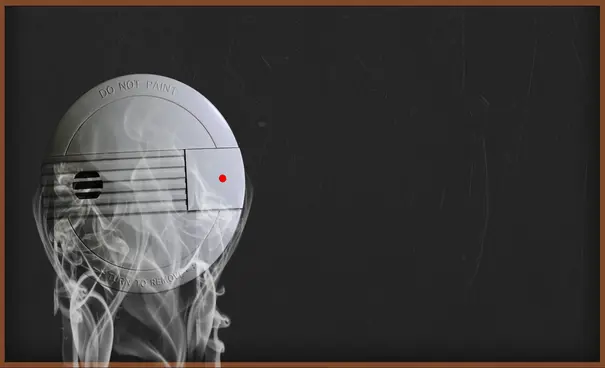Not all detectors are built for the same purpose. A fire detector protects you against fire. A vape detector protects your space against vaping. If you want to figure out which one you really need for safety, regulation, or behavior modification, this guide breaks it down so you won’t waste money on the wrong solution.
What is a smoke detector?
Smoke detectors use optical or ionization sensors to detect particles released during combustion. These are essential for identifying fires at an early stage and are designed to catch signs of fire.
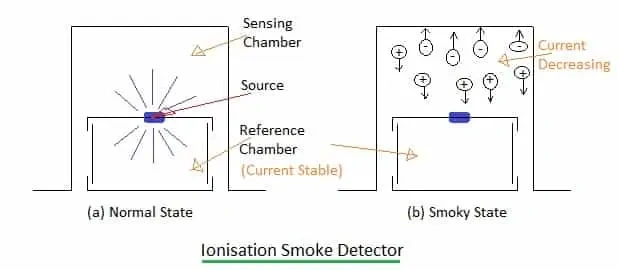
Now you may ask, can smoke detectors detect vape smoke? Traditional smoke detectors struggle to detect vape smoke because the aerosol particles are much smaller and lighter than those in real smoke from a fire.
Vape smoke doesn’t have the same density or heat signature as combustion, so standard sensors often miss it. They use ionization or photoelectric sensors to identify large particles produced by combustion, the kind that is visible when something is actually burning. When they detect these particles, they trigger loud, public alarms to warn everyone nearby and help save lives.
What is a vape detector?
Vape detectors are designed to recognize aerosolized vapor particles produced by e-cigarettes, something traditional smoke detectors often misinterpret. They are made to sense the much smaller and lighter particles in e-cigarette vapor.
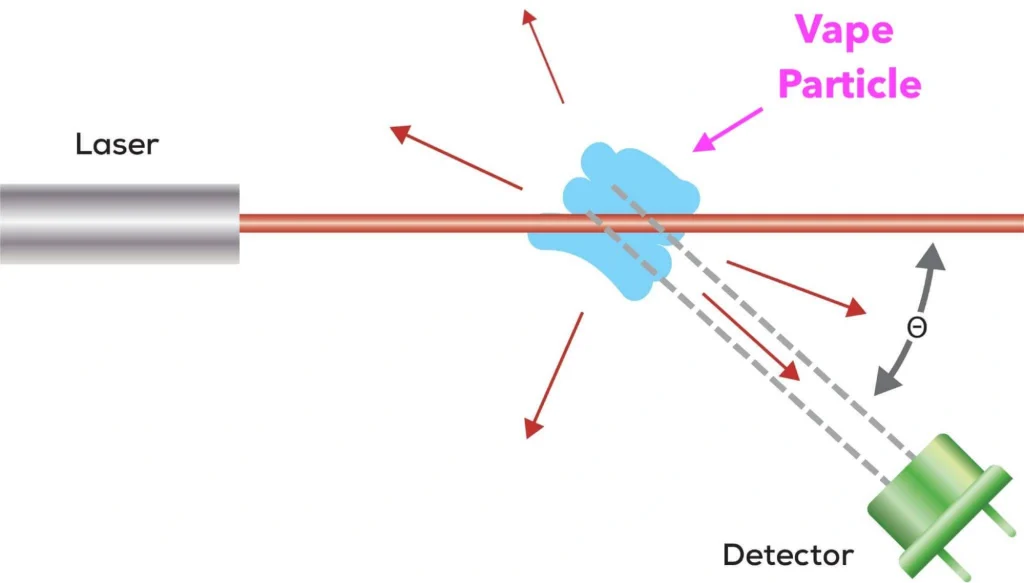
Instead of responding to burning materials, they use laser-based particle sensors and advanced algorithms to detect the fine mist generated by vaping. Many also include chemical sensors that recognize the compounds found in aerosolized nicotine or THC.
Can vape smoke set off a fire alarm?
It’s possible but not common. If someone vapes heavily right under a smoke detector, the dense aerosol could mimic smoke enough to trigger an alarm. However, most everyday vaping doesn’t set off fire alarms because the vapor particles are too fine. This is why schools and hotels often install dedicated vape detectors alongside traditional smoke detectors for accurate, separate monitoring.
The main differences of vape detector vs smoke detector:
- Technology: Vape detectors rely on lasers and algorithms, while smoke detectors respond to light scattering or electrical changes caused by smoke.
- Sensitivity: Vape detectors are far more sensitive, able to detect even trace vapor that traditional smoke sensors miss.
- Alerts: Vape detectors typically send private notifications to administrators (such as school staff or building managers), whereas smoke detectors trigger public alarms to evacuate everyone.
- Purpose: Vape detectors help stop illicit vaping and enforce safety policies. Smoke detectors exist to save lives in the event of a fire.
These are the differences that prevent regular smoke detectors from detecting vaping.
Do vape detectors and smoke detectors give false alarms?
Yes, false alarms are a common occurrence in traditional detectors when exposed to vapor, fog, or even dust. These non-combustion particles can mimic smoke, triggering unnecessary alerts that disrupt operations and reduce trust in the system.
That’s where advanced detection technology comes in.
Honeywell and Bosch lead the industry in precision-engineered smoke detection hardware, minimizing false positives. Some top-notch AI systems take it further with early warning sensors that identify both smoke and vapors at trace levels, long before they become visible.
With integrated platforms, facilities can now connect multiple sensors to monitor various environmental triggers through a single, intelligent system.
How does AI smoke detection work?

For AI smoke detection, you need to place AI cameras to recognize the visual signs of smoke or vaping by detecting movement, texture, color shifts, and how particles spread through the air.
There’s no physical detector needed. When the AI detects those visual patterns, it flags them in real-time, allowing people to check and act more quickly. Here’s a list of types of fumes or emissions that those AI detection features can identify:
- Cigarette smoke
- Vape aerosol (nicotine and THC vapor)
- Cigar smoke
- Incense smoke
- Burning paper or fabric smoke
- Electrical short-circuit smoke
- Smoldering fire haze (slow-burning materials)
- Fog machine vapor (often flagged but recognizable with trained models)
- Combustion byproducts (carbonized or soot-heavy plumes)
The simple step-by-step of what happens:
It begins when a camera, either a standard IP model or one with advanced video analytics integrated on live video feeds.
Image-based detection:
Each frame is then analyzed by deep learning models. They are trained to spot smoke or vape features such as:
- Thin wisps. Narrow, curling trails typical of cigarette or early fire smoke.
- Semi-transparent regions. Light, see-through vapor clouds from vaping or mild combustion.
- Flickering dispersion patterns. Irregular, wave-like motion caused by airflow or exhaled vapor.
- Billowing plumes. Dense, expanding smoke masses from fire or heavy vapor use.
- Vertical drift. Slow, upward movement indicating heat-based convection (like fire smoke).
- Color gradient shifts. Transitions from white to gray or blue tones, typical in vapor and light smoke.
- Thermal shimmer. Visible distortion from heat sources (detectable with thermal analytics).
- Edge flicker. Boundary movement where smoke interacts with lighting.
Temporal checks:
To reduce false alarms, the AI runs temporal checks comparing multiple frames and analyzing how haze evolves over time. This helps it distinguish between harmless fog or dust and actual smoke.
Alerting and verification:
Once the system reaches high confidence, it triggers alerting and verification steps, sending a video clip or snapshot to operators or dashboards, and, if necessary, activating actions such as push notifications, sprinkler holds, or verified alarms.
Why image-based AI helps:
AI-powered smoke detection outperforms conventional sensors in areas where they are weak, such as in darkness, at low light levels, and in the presence of white or dark clouds. Even in big rooms, open spaces, or where fog, dust, or steam tends to produce false alarms. Visible smoke, vape clouds, or even patterns of heat can be viewed by cameras where there is no wiring for physical detectors.
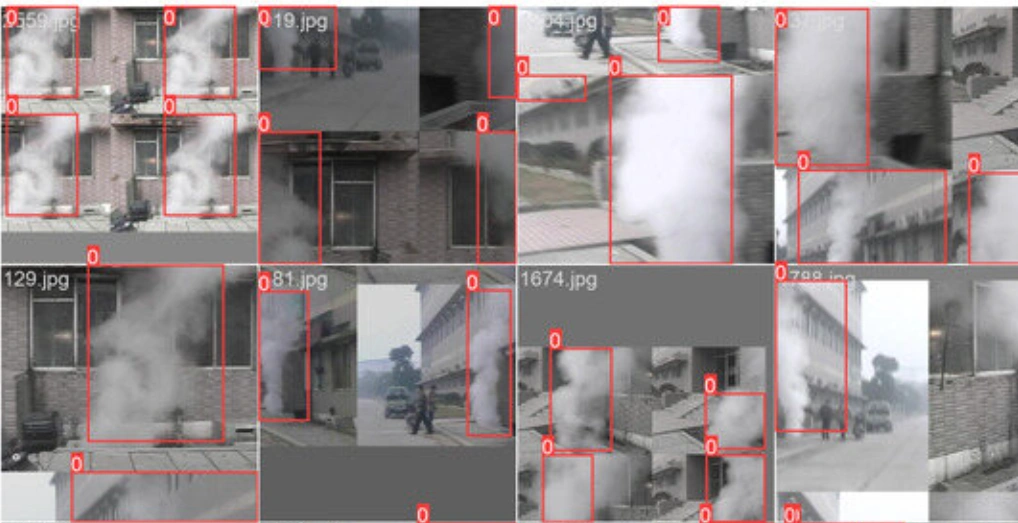
Advanced AI analytics also provides early visual alerts, detecting subtle wisps of smoke before a plume becomes visible to the naked eye.
That’s the level of precision modern AI has reached; it doesn’t merely see smoke, it interprets it.
Each wafer-thin wisp, each half-transparent swirl, each quiver of vapor in motion is broken down frame by frame.
Now imagine that same intelligence scaled up. Across massive warehouses, multi-level parking structures, and open industrial yards, AI-powered cameras track even the faintest trace of smoke or vapor that human eyes might miss.
Nothing gets away from the camera. No smoldering ember in a corner, no concealed vape cloud under dim lighting.
This is next-gen AI smoke and vape detection.
Remote Video Monitoring:
But spotting smoke or vapor isn’t enough. You don’t just want a system that detects, you want one that acts.
That’s where Remote Video Monitoring comes in. When Smoke and Fire Detection AI detects signs of smoke or vaping, trained security operators respond immediately. They check the live feed, confirm what’s happening, and take action before it spreads.
They can speak directly to people on-site, trigger alarms, or call emergency services all within seconds and according to preset SOPs.
It’s smart technology backed by real people who know what to do when every second matters.
How do vape detectors work without infringing on privacy?
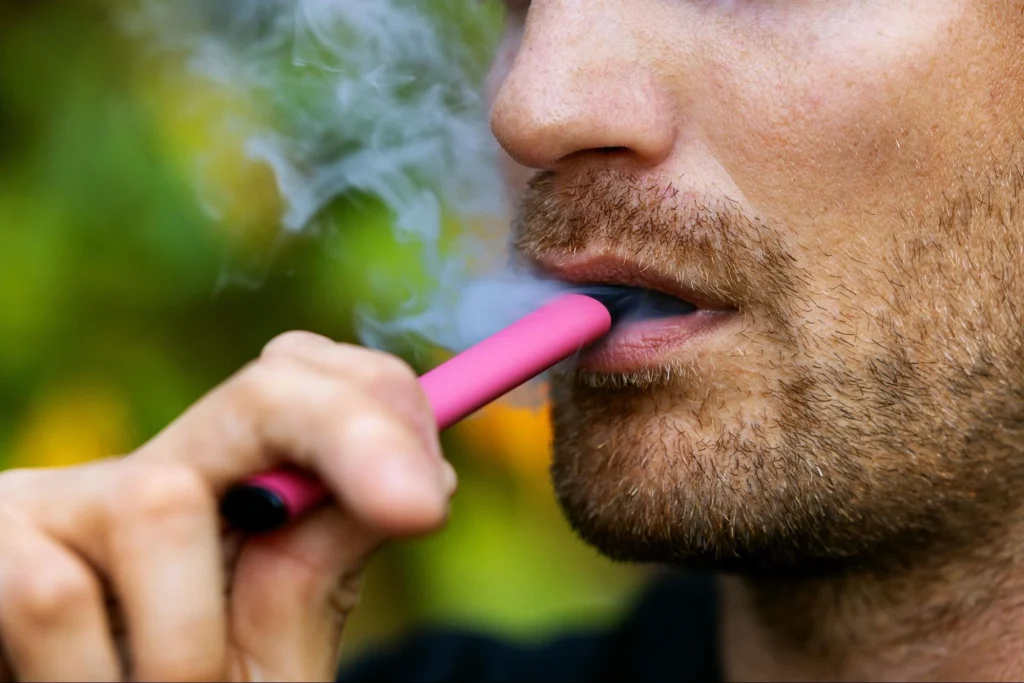
Individuals tend to fear that AI cameras imply constant surveillance, but that is not the reality.
AI smoke and vape detection is not about monitoring people. It looks at visual patterns like fine wisps, vapor trails, or thermal changes indicative of smoking or vaping. The system doesn’t recognize faces or monitor individual behavior.
It detects smoke-like activity in real time and instantly triggers an alarm. No data stored, no footage shared, just swift action to keep everyone safe.
For schools, hotels, and workplaces, that balance is important. You receive wiser protection without invading privacy boundaries.
Are vape detectors worth the cost for schools, hotels, and businesses?
Yes. Vape detectors often pay for themselves within a few years by reducing incidents, preventing fines, and protecting your reputation.
As Pieter Claerhout, CEO of Araani, explains:
“Fire detectors are often affected by dust, humidity, or toxic fumes, causing them to break down and frequently sound false alarms, which in the end prompts employees to just turn off the detector.” Vape detectors and AI-based smoke systems address this issue by providing smarter, more reliable detection.
Breaking down ROI:
- For schools, vape detectors reduce disciplinary time, improve air quality, and help maintain a safe environment for students and staff.
- For hotels, this reduces costly room cleanups, avoids guest complaints, and protects brand ratings.
- For businesses and warehouses, they prevent downtime, reduce insurance risks, and ensure compliance with safety policies.
Even a few avoided incidents each year can cover the installation cost. For example, a school installing ten vape detectors at $1,000 each might save $2,000 – $3,000 per year in staff time, remediation, and fines, reaching full payback in about three to four years.
Smoke detector vs vape detector: Which one should you choose?
| Feature | Smoke detector | Vape detector | AI camera smoke detection |
|---|---|---|---|
| Primary purpose | Detects smoke from fire or burning materials | Detects vapor from e-cigarettes and vaping devices | Detects visible smoke, vapor, or heat anomalies through image analysis |
| Core technology | Ionization or photoelectric sensors | Laser-based and chemical particle sensors | AI-powered computer vision analyzes color, motion, and texture changes |
| Particle sensitivity | Responds to larger particles from combustion | Detects fine, aerosolized vapor particles | Detects visual patterns like thin wisps, flickering trails, and haze evolution |
| Detection focus | Fire safety and life protection | Vaping behavior and air quality control | Early smoke or vapor detection across wide areas, indoor and outdoor |
| Alert type | Loud public alarms | Silent notifications to admins | Real-time visual alerts with verification video clips |
| Coverage area | Limited to rooms or enclosed spaces | Small to medium enclosed spaces | Covers vast spaces like warehouses, car parks, and open yards |
| False alarm risk | Can trigger on dust, vapor, or steam | May trigger in heavy fog or perfume mist | AI trained to distinguish fog, dust, and steam through motion and temporal checks |
| Integration options | Fire alarms, sprinklers, and BMS systems | Cloud dashboards or facility monitoring tools | Integrates with remote video monitoring, analytics platforms, and multi-sensor systems |
| Privacy considerations | No video or data stored | Usually no video capture | Detects smoke/vapor patterns without identifying faces or storing footage |
| Response capability | Triggers alarms for occupants to respond | Notifies staff of enforcement action | Enables trained operators to verify, speak on-site, trigger alarms, or call responders instantly |
| Best use case | Fire detection and life safety | Vape control in schools, hotels, and offices | Comprehensive protection for large, high-risk, or outdoor environments |
| Example brands | Honeywell, Bosch, Ajax | Forensics Detectors, Halo, Zeptive | Araani, Bosch IVA, Unv, Irisity, Network Optix |
Frequently asked questions:
Can smoke and fire detection be used in areas not covered by smoke detectors?
Yes, video smoke detection utilizes cameras and analytics to identify visible smoke or fire within a camera’s field of vision, making it well-suited for high ceilings, car parks, and outdoor spaces where point detectors can’t reach.
Can vape detectors detect even on foggy days or distinguish between vape and fog?
Modern vape detection systems (and AI video tools) can distinguish vaping from fog in many situations, but heavy natural fog or theatrical fog can still cause false positives unless you use multi-sensor or AI-trained solutions.
Vape detectors typically employ particle/aerosol sensors and VOC or nicotine-sensing chemistry, while video/AI systems utilize visual signatures. Vendors train algorithms to ignore background fog/sustained environmental aerosols and to recognize vaping patterns.
Can AI smoke detection be used both indoors and outdoors?
Yes, smoke detection products are designed for both indoor and outdoor deployment, although outdoor use requires weather-aware models and specific camera choices.
AI models are trained on outdoor conditions (such as sun, clouds, and headlights) and indoor scenes, enabling detection across various environments. However, outdoor implementations require cameras rated for the environment and models tuned for moving backgrounds and changing light conditions.
Is AI smoke detection more efficient than traditional sensors?
Yes. Systems combining Xtralis VESDA precision with AI video analytics (from Irisity or Actuate) offer earlier detection, and fewer false alarms.
Do vape detectors also detect cigarette smoke?
Many AI-integrated vape detection systems (e.g., Ajax or Xtralis) can identify both cigarette and vapor emissions.
Is AI smoke detection capable of detecting slow-burning smoldering fires?
Smoldering fires emit less visible smoke, so photoelectric detectors consistently beat visual systems in certain smoldering situations. However, AI video (and thermal imaging) has the ability to detect visible plumes or heat signatures in most smoldering situations, making a hybrid approach the best choice.
Conclusion:
If your goal is fire prevention and safety compliance, a smoke detector is essential.
If your concern is vaping, air quality, or policy enforcement, a vape detector is the better fit.
For large facilities such as warehouses or parking lots, combining AI smoke detection cameras with remote video monitoring offers the best of both worlds: early warning, verified response, and zero false alarms. Contact us today to find out how businesses across North America are benefiting from smoke detection AI.

